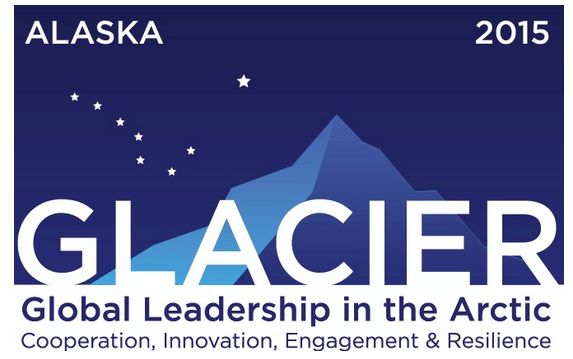The ‘Conference on Global Leadership in the Arctic: Cooperation, Innovation, Engagement and Resilience (GLACIER)' convened to highlight international and domestic priorities in the Arctic, define critical challenges facing the region, raise awareness about climate change impacts in the Arctic, and focus on innovative approaches to address challenges at the local, national and international levels.
 1 September 2015: The US Government convened the ‘Conference on Global Leadership in the Arctic: Cooperation, Innovation, Engagement and Resilience (GLACIER)’ to highlight international and domestic priorities in the Arctic, define critical challenges facing the region, raise awareness about climate change impacts in the Arctic, and focus on innovative approaches to address challenges at the local, national and international levels.
1 September 2015: The US Government convened the ‘Conference on Global Leadership in the Arctic: Cooperation, Innovation, Engagement and Resilience (GLACIER)’ to highlight international and domestic priorities in the Arctic, define critical challenges facing the region, raise awareness about climate change impacts in the Arctic, and focus on innovative approaches to address challenges at the local, national and international levels.
More than 400 participants attended the conference, which was hosted by the US Department of State and convened in Anchorage, Alaska, US on 31 August 2015. Participants included representatives from eight Arctic states as well as countries and intergovernmental bodies with interests in the Arctic, including representatives from Canada, China, Denmark, Finland, France, Germany, Iceland, India, Italy, Japan, the Republic of Korea, the Netherlands, Norway, Poland, the Russian Federation, Singapore, Spain, Sweden, the US, the UK and the EU. Indigenous leaders and public and private sector representatives from Alaska and the Arctic region also attended. US Secretary of State John Kerry provided welcoming remarks and US President Barack Obama delivered closing remarks.
Ministerial sessions focused on: the Arctic’s unique role in influencing the global climate, chaired by Norwegian Foreign Minister Børge Brende; climate resilience and adaptation planning, chaired by Swedish Foreign Minister Margot Wallström; and strengthening Arctic cooperation and coordination, chaired by Finnish Foreign Minister Timo Soini.
Parallel sessions addressed, inter alia: climate change resilience; strengthening emergency response; black carbon and air quality; preventing unregulated fisheries; renewable energy; healthy Arctic homes; strengthening observation networks; and innovative solutions to economic efficiency and community health.
Also discussed during the conference was the Arctic Contaminants Action Program’s (ACAP) publication, titled ‘Reduction of Black Carbon Emissions from Residential Wood Combustion in the Arctic,’ which makes recommendations for reducing black carbon emissions from residential wood stoves. In addition, the ACAP projects ‘Community Based Black Carbon and Public Health Assessment’ and ‘Circumpolar Local Environmental Observer Network for Traditional Environmental Knowledge (CLEO)’ were presented. CLEO, a crowdsourcing or citizen-science platform, seeks to expand the existing Local Environmental Observer Network (LEO) to the circumpolar region. ACAP was founded as an Arctic Council plan to address Arctic pollution sources, and aims to encourage national actions to reduce emissions and the release of other pollutants.
In his address to GLACIER, President Obama said the Arctic is a leading indicator of what the entire planet faces due to climate change and, noting that Arctic temperatures are rising twice as fast as the global average, underscored that Alaska has warmed twice as fast as the rest of the US over the past 60 years. He highlighted that: thawing permafrost threatens homes and damages transportation and energy infrastructure; Alaska has some of the swiftest shoreline erosion rates in the world; Alaska’s fire season is more than a month longer than it was in 1950; and if action is not taken, Alaska’s temperatures could rise between six and 12°C by the end of the century. Obama also said that an agreement must be reached in Paris in December, noting that those who want to ignore climate science are increasingly alone on “their own shrinking island.”
A joint statement on climate change and the Arctic released at the conclusion of the conference, inter alia: reaffirms the commitment of the Arctic and other countries to achieve a successful outcome in Paris; acknowledges the importance of the Framework for Action on Black Carbon and Methane; encourages oil and gas firms to join the Climate and Clean Air Coalition’s (CCAC) Oil and Gas Methane Partnership; and calls for additional research to assist in the response of Arctic permafrost and other carbon reservoirs to warming. The statement further: urges the scientific community to continue providing information and tools to assist the Arctic’s most vulnerable communities in building resilience and to prioritize further research on links between a changing Arctic and impacts felt worldwide; and resolves to work with Arctic communities to deploy low-carbon solutions.
GLACIER, which took place during the two-year term of the US as Chair of the Arctic Council (although not as a Council-sponsored event), aimed to help drive political will for ambitious action in Paris by highlighting how the Arctic is experiencing and responding to climate impacts. [GLACIER Website] [Chair’s Summary] [Joint Statement on Climate Change and the Arctic] [Remarks by US President Barack Obama] [Remarks by US Secretary of State John Kerry] [Introduction of President Obama by Secretary Kerry] [Arctic Council Press Release] [Reduction of Black Carbon Emissions from Residential Wood Combustion in the Arctic]